门诊静脉采血流程
- 格式:doc
- 大小:26.00 KB
- 文档页数:1
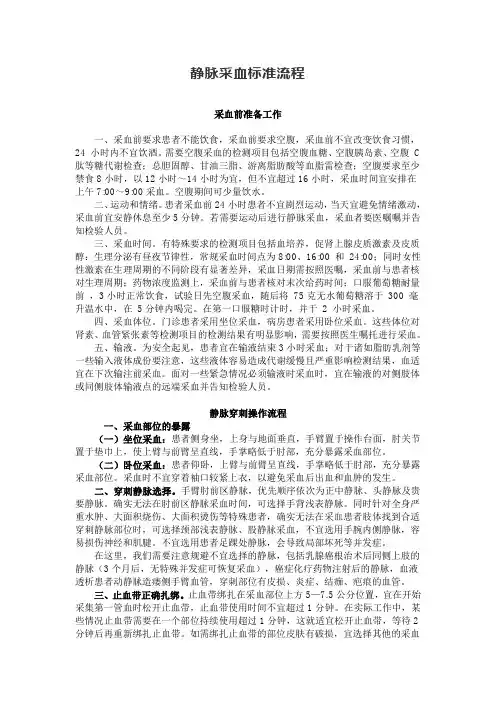
静脉采血标准流程采血前准备工作一、采血前要求患者不能饮食,采血前要求空腹,采血前不宜改变饮食习惯,24 小时内不宜饮酒。
需要空腹采血的检测项目包括空腹血糖、空腹胰岛素、空腹C 肽等糖代谢检查;总胆固醇、甘油三脂、游离脂肪酸等血脂雷检查;空腹要求至少禁食8小时,以12小时~14小时为宜,但不宜超过16小时,采血时间宜安排在上午7:00~9:00采血。
空腹期间可少量饮水。
二、运动和情绪。
患者采血前24小时患者不宜剧烈运动,当天宜避免情绪激动,采血前宜安静休息至少5分钟。
若需要运动后进行静脉采血,采血者要医嘱嘱并告知检验人员。
三、采血时间。
有特殊要求的检测项目包括血培养,促肾上腺皮质激素及皮质醇:生理分泌有昼夜节律性,常规采血时间点为8:00、16:00 和24:00;同时女性性激素在生理周期的不同阶段有显著差异,采血日期需按照医嘱,采血前与患者核对生理周期;药物浓度监测上,采血前与患者核对末次给药时间;口服葡萄糖耐量前,3小时正常饮食,试验日先空腹采血,随后将75克无水葡萄糖溶于300 毫升温水中,在5分钟内喝完。
在第一口服糖时计时,并于 2 小时采血。
四、采血体位。
门诊患者采用坐位采血,病房患者采用卧位采血。
这些体位对肾素、血管紧张素等检测项目的检测结果有明显影响,需要按照医生嘱托进行采血。
五、输液。
为安全起见,患者宜在输液结束3小时采血;对于诸如脂肪乳剂等一些输入液体成份要注意,这些液体容易造成代谢缓慢且严重影响检测结果,血适宜在下次输注前采血。
面对一些紧急情况必须输液时采血时,宜在输液的对侧肢体或同侧肢体输液点的远端采血并告知检验人员。
静脉穿刺操作流程一、采血部位的暴露(一)坐位采血:患者侧身坐,上身与地面垂直,手臂置于操作台面,肘关节置于垫巾上,使上臂与前臂呈直线,手掌略低于肘部,充分暴露采血部位。
(二)卧位采血:患者仰卧,上臂与前臂呈直线,手掌略低于肘部,充分暴露采血部位。
采血时不宜穿着袖口较紧上衣,以避免采血后出血和血肿的发生。
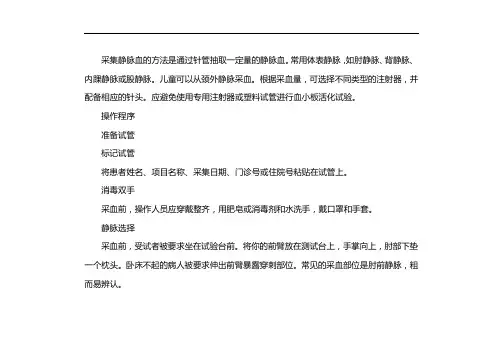
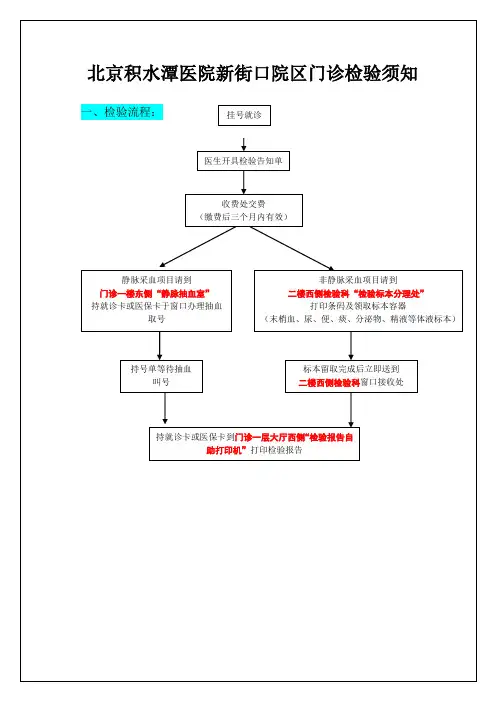
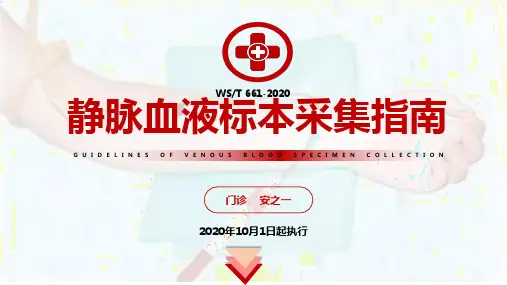
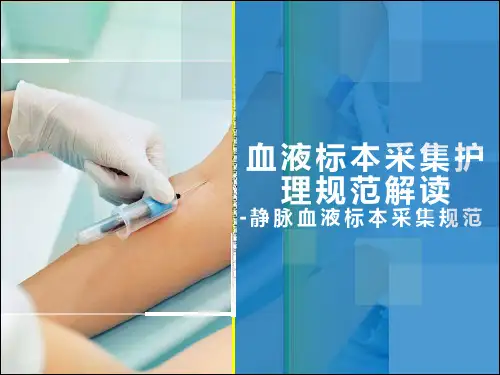
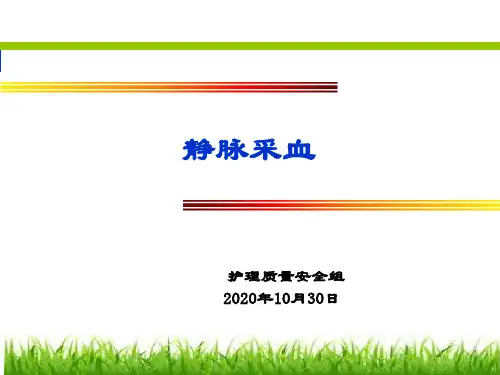
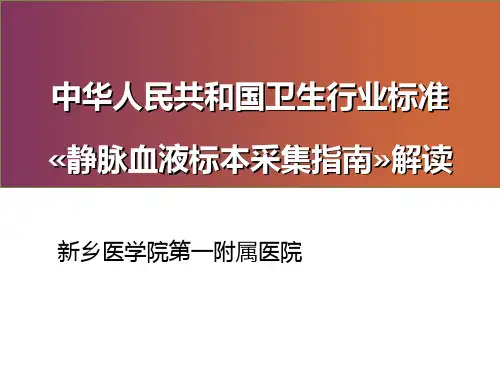
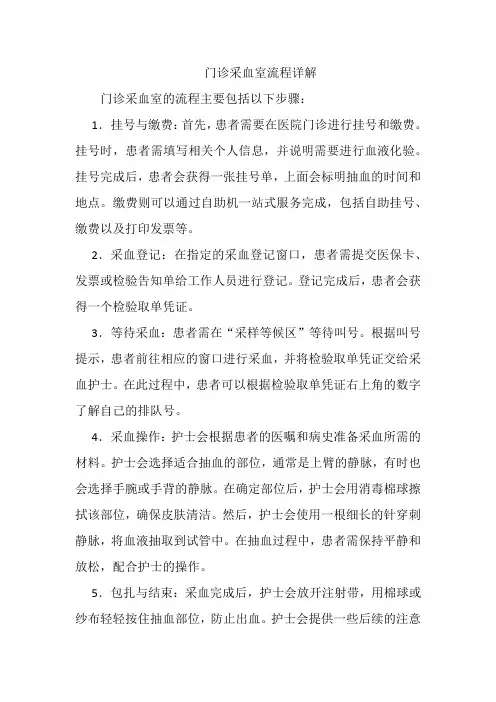
门诊采血室流程详解
门诊采血室的流程主要包括以下步骤:
1.挂号与缴费:首先,患者需要在医院门诊进行挂号和缴费。
挂号时,患者需填写相关个人信息,并说明需要进行血液化验。
挂号完成后,患者会获得一张挂号单,上面会标明抽血的时间和地点。
缴费则可以通过自助机一站式服务完成,包括自助挂号、缴费以及打印发票等。
2.采血登记:在指定的采血登记窗口,患者需提交医保卡、发票或检验告知单给工作人员进行登记。
登记完成后,患者会获得一个检验取单凭证。
3.等待采血:患者需在“采样等候区”等待叫号。
根据叫号提示,患者前往相应的窗口进行采血,并将检验取单凭证交给采血护士。
在此过程中,患者可以根据检验取单凭证右上角的数字了解自己的排队号。
4.采血操作:护士会根据患者的医嘱和病史准备采血所需的材料。
护士会选择适合抽血的部位,通常是上臂的静脉,有时也会选择手腕或手背的静脉。
在确定部位后,护士会用消毒棉球擦拭该部位,确保皮肤清洁。
然后,护士会使用一根细长的针穿刺静脉,将血液抽取到试管中。
在抽血过程中,患者需保持平静和放松,配合护士的操作。
5.包扎与结束:采血完成后,护士会放开注射带,用棉球或纱布轻轻按住抽血部位,防止出血。
护士会提供一些后续的注意
事项,如保持休息、饮食等。
同时,护士会发放化验结果的条码,患者可以根据条码上的提示在指定的自助报告机领取化验结果。
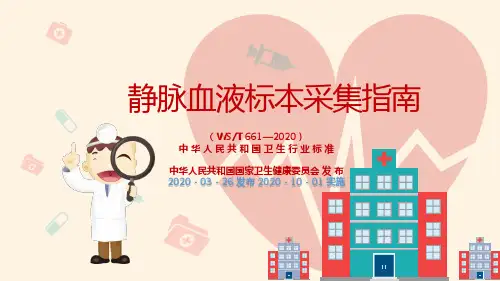
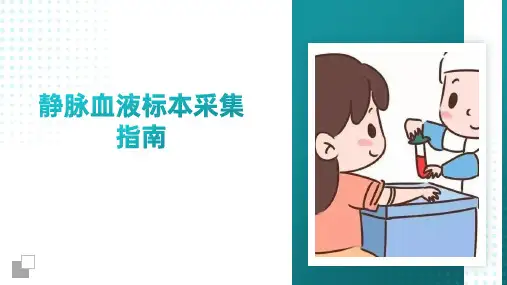
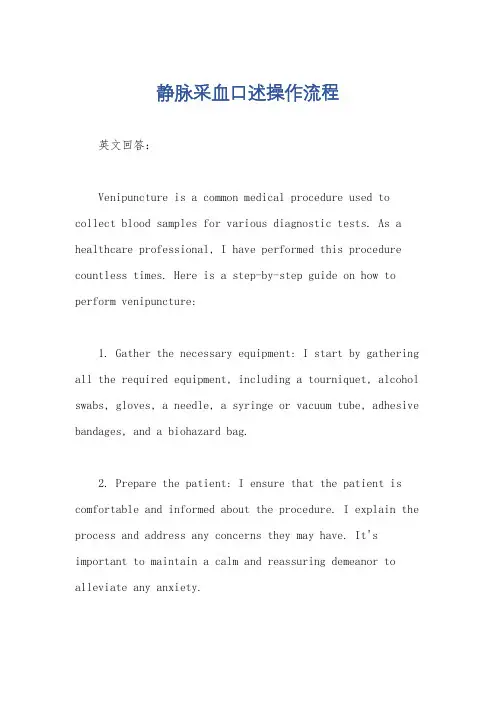
静脉采血口述操作流程英文回答:Venipuncture is a common medical procedure used to collect blood samples for various diagnostic tests. As a healthcare professional, I have performed this procedure countless times. Here is a step-by-step guide on how to perform venipuncture:1. Gather the necessary equipment: I start by gathering all the required equipment, including a tourniquet, alcohol swabs, gloves, a needle, a syringe or vacuum tube, adhesive bandages, and a biohazard bag.2. Prepare the patient: I ensure that the patient is comfortable and informed about the procedure. I explain the process and address any concerns they may have. It's important to maintain a calm and reassuring demeanor to alleviate any anxiety.3. Select the appropriate vein: I examine the patient's arm to identify a suitable vein for venipuncture. The most commonly used veins are the median cubital vein, cephalic vein, and basilic vein. I choose a vein that is visible, palpable, and easily accessible.4. Apply the tourniquet: I ask the patient to make a fist and apply the tourniquet about 3-4 inches above the intended puncture site. The tourniquet helps to distend the vein, making it easier to locate and access.5. Clean the site: I clean the selected puncture site with an alcohol swab, using a circular motion starting from the center and moving outward. This helps to disinfect the area and prevent infection.6. Put on gloves: I put on a pair of sterile gloves to maintain aseptic technique and prevent cross-contamination.7. Insert the needle: Holding the needle at a 15-30 degree angle, I insert it into the vein with a quick, smooth motion. I always aim to enter the vein in one swiftmovement to minimize discomfort for the patient.8. Collect the blood sample: Once the needle is properly inserted, I either attach a syringe or vacuum tube to collect the blood sample. The amount of blood required depends on the specific tests ordered by the physician.9. Release the tourniquet: After collecting the required amount of blood, I release the tourniquet to restore normal blood flow in the patient's arm.10. Remove the needle: I withdraw the needle gently and apply pressure to the puncture site with a sterile gauze pad to prevent bleeding. I also ask the patient to apply pressure to the site for a few minutes to aid in clotting.11. Dispose of the needle and other sharps: I carefully dispose of the used needle and other sharps in a biohazard bag to ensure proper disposal and prevent accidental needlestick injuries.12. Apply adhesive bandage: I apply an adhesive bandageto the puncture site to protect it and provide comfort tothe patient.中文回答:静脉采血是一种常见的医疗程序,用于采集血液样本进行各种诊断测试。
2020 静脉血液采集指南(完整版)导语国家卫健委发布的成年人静脉血液标本采集最新行业标准,WS/T 661-2020 静脉血液标本采集指南将从2020年10月1日起执行。
采血前患者的准备一、饮食(空腹要求)患者在采血前不宜改变饮食习惯,24 h 内不宜饮酒。
需要空腹采血的检测项目包括(不限于):糖代谢:空腹血糖、空腹胰岛素、空腹 C 肽等;血脂:总胆固醇、甘油三脂、高密度脂蛋白胆固醇、低密度脂蛋白胆固醇、载脂蛋白A1、载脂蛋白B、脂蛋白a、载脂蛋白E、游离脂肪酸等;血液流变学(血粘度);骨代谢标志物:骨钙素、I 型胶原羧基端肽β特殊序列、骨碱性磷酸酶等;血小板聚集率(比浊法)。
空腹要求至少禁食8 h,以12 h~14 h为宜,但不宜超过16h。
宜安排在上午7:00~9:00采血。
空腹期间可少量饮水。
二、运动和情绪采血前24h,患者不宜剧烈运动,采血当天患者宜避免情绪激动,采血前宜静息至少5min。
若需运动后采血,则遵循医嘱,并告知检验人员。
三、采血时间采血时间有特殊要求的检测项目包括(不限于):血培养:寒战或发热初起时,抗生素应用之前采集最佳,其他特殊要求见WS/T 503;促肾上腺皮质激素及皮质醇:生理分泌有昼夜节律性,常规采血时间点为8:00、16:00 和24:00;女性性激素:生理周期的不同阶段有显著差异,采血日期需遵循医嘱,采血前与患者核对生理周期;药物浓度监测:具体采血时间需遵循医嘱,采血前与患者核对末次给药时间;口服葡萄糖耐量试验:试验前 3 d 正常饮食,试验日先空腹采血,随后将75 g 无水葡萄糖(相当于82.5 g 含一水葡萄糖)溶于300 ml 温水中,在 5 min 内喝完。
在第一口服糖时计时,并于 2 h 采血,其他时间点采血需遵循医嘱;其他功能试验:根据相关临床指南推荐的功能试验方案所设定的时间采血;血液疟原虫检查:最佳采血时间为寒颤发作时。
四、采血体位门诊患者采用坐位采血,病房患者采用卧位采血。
静脉采血的口述流程Venipuncture is a common medical procedure used to collect blood for various tests and diagnostic purposes. 静脉采血是一种常见的医疗程序,用于收集血液进行各种测试和诊断目的。
The process involves inserting a needle into a vein to draw blood, which can be a daunting experience for some individuals. 这个过程涉及插入针头到血管中抽取血液,这对一些人来说可能是一次令人畏惧的经历。
However, it is essential for healthcare professionals to ensure that the procedure is carried out with the utmost care and precision to minimize discomfort and potential complications. 但是,对于医疗保健专业人员来说,确保这个程序被精心和精确地执行以最大程度地减少不适和潜在的并发症是至关重要的。
One of the first steps in the venipuncture process is to properly prepare the individual for the procedure. 静脉采血过程中的第一步是为这个程序适当地准备个体。
This includes explaining the purpose of the blood draw, obtaining consent, and addressing any concerns or questions the individual may have. 这包括解释抽血的目的,获得同意,并解决个体可能有的任何疑虑或问题。
门诊采血室流程详解Working in a blood drawing room can be a challenging but rewarding experience. The process of collecting blood samples from patients is a critical step in diagnosing and treating various medical conditions. 在门诊采血室工作可能是一个具有挑战性但又令人满足的经历。
从患者身上采集血样是诊断和治疗各种疾病的一个关键步骤。
As a phlebotomist, one must have excellent communication skills to calm nervous patients and ensure they understand the process. It is important to create a welcoming and comfortable environment for patients to help ease their anxiety about getting their blood drawn. 作为一个静脉采血员,必须具备出色的沟通技巧,以平息紧张的患者,并确保他们理解整个过程。
营造一个亲切舒适的环境对于帮助患者减轻对采血的焦虑是非常重要的。
Additionally, attention to detail is crucial when preparing the equipment and verifying patient information to avoid any potential errors during the blood drawing process. Double-checking labels, identifying the correct patient, and ensuring proper sample collection procedures are essential to maintaining accuracy andpatient safety. 此外,在准备设备和确认患者信息时注意细节至关重要,以避免在采血过程中出现任何潜在错误。
静脉采血的注意事项在血液检查时,静脉采血是一个重要环节,血液样本的质量直接影响检查结果,为临床诊疗提供科学依据。
静脉采血时,有哪些常用方法?人们应该注意些什么?下面对此进行简单论述。
1.静脉采血的操作程序静脉采血时,多选择体表的浅静脉,例如肘静脉、手背静脉、股静脉、内踝静脉等,小儿还可以选择颈外静脉。
以注射器采血为例,根据采血量不同,选择合适的注射器和针头,操作程序是:①准备试管。
②标记试管。
在试管上贴上标签,记录受检者的姓名、项目名称、采集日期、门诊或住院号。
③消毒双手。
采血人员要衣帽整齐,按照标准方法洗手,佩戴口罩和手套。
④选择静脉。
受检者坐在实验台前,将前臂放在实验台上,掌心向上,肘下放枕垫,暴露出肘前静脉,方便辨认血管。
⑤检查注射器。
打开一次性注射器包装,连接针头、针筒,抽拉针栓检查有无阻塞和漏气,排尽空气备用,针头处于无菌状态。
⑥扎压脉带。
在采血部位上端6-10cm处,使用压脉带绕手臂一圈打活结,患者紧握、放松拳头几次,促使静脉隆起。
⑦选择进针部位,利用左食指触摸进针部位的静脉。
⑧消毒。
先使用碘酊棉签在静脉穿刺处消毒皮肤,再使用乙醇棉签擦拭待干。
⑨穿刺。
沿静脉走向,针头与皮肤呈30°角,斜向快速刺入皮肤,然后呈5°角向前穿破静脉壁进入静脉腔,确认针尖位于静脉中心。
⑩抽血。
缓慢后拉注射器针栓,见少量回血后松开压脉带,直至达到采血量刻度。
⑪止血。
受检者松拳,使用消毒棉签压住进针点,迅速拔出针头,按压消毒棉签3-5min。
⑫取下针头,将血液沿试管壁缓慢注入,到达标记处。
2.静脉采血时常用的方法(1)注射器。
手持一次性注射器,选择合适静脉,将针头刺入静脉,见到回血后,缓慢回抽针栓,抽取需要的血量。
抽血完成后,松开止血带,要求受检者松开拳头,迅速拔出针头,利用无菌棉签按压进针点。
(2)真空采血器。
手持真空采血器,将针头一端刺入静脉,见到回血后,将另一端插入真空试管,在负压作用下血液流进试管,到达刻度线即可。